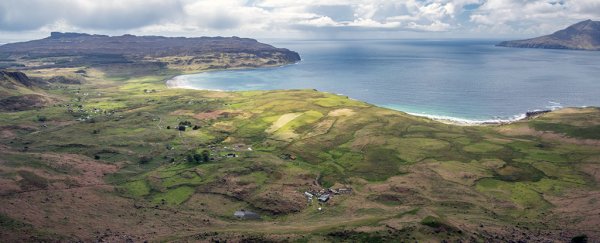If you want a template for making renewable energy work in the here and now, look no further than the Scottish island of Eigg, which is powered almost completely by wind, solar, and hydro technology.
The off-grid electricity system on this 30-square-kilometre (12-square-mile) island has been running since 2008, and stands as a fine example of both the potential of renewable energy, and the way remote communities can support themselves.
In fact, researchers from around the world are now visiting Eigg to see how the islanders are keeping the lights on without demanding too much from the planet.
Eigg's power system uses a careful balance of its three energy sources – the Sun, the wind, and the waves – to make sure there's a constant supply of electricity. It's the combination of the three that makes the system work.
What makes the setup even more remarkable is that everything is managed and maintained by the Eigg residents themselves, via a community-owned company called Eigg Electric.
 The Eigg power system. Credit: Zbigniew Chmiel
The Eigg power system. Credit: Zbigniew Chmiel
"The whole thing is run by and for the island," ex-Eigg Electric director John Booth told Karen Gardiner from the BBC.
Supplying the island's energy needs are three hydroelectric generators – one larger 100kW hydro turbine and two smaller 5-6kW units – plus four 6kW wind turbines and a 50kW photovoltaic array.
When backup energy is needed, it's provided by two 70kw diesel generators, with 11 kilometres (7 miles) of cabling knitting everything together.
On average, the renewable energy system supplies 90 to 95 percent of the island's power. During times when a surplus is being created, a bank of 96 4-volt batteries are used to store excess energy for when it's needed.
When those batteries are full – usually in the midst of winter, when rainfall and winds are at their highest – electric heaters automatically switch on in the church and community hall so that nothing is wasted.
But limits are in place to encourage residents to use power responsibly: islanders are asked to keep below 5kW of energy use at any one time, about the equivalent of running a kettle and a washing machine at the same time. Businesses get a 10kW upper limit.
Anyone who goes above that limit gets their power temporarily cut off along with a small fine, and has to call Eigg Electric to get back up and running.
Meanwhile, a traffic light system on the pier lets the community know how the system is running – green means everything is normal, red means the Eigg grid is under strain, and amber is somewhere in the middle.
Groups from as far away as Brazil and Malawi have visited Eigg to see how the island's system could be adapted for other remote communities that don't enjoy reliable access to a national power grid.
And even with a more than 50 percent rise in the island population since the system was first installed, Eigg's renewable power network is holding up.
A 2015 study of the grid suggested even more capacity could be added with extra wind turbines.
"The demand on the system is rising," says Booth. "But all the evidence says that we got it right at the outset and it's coping."
